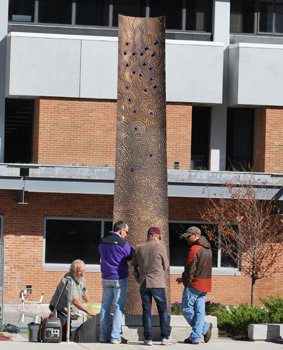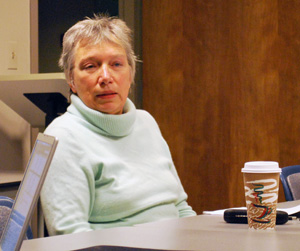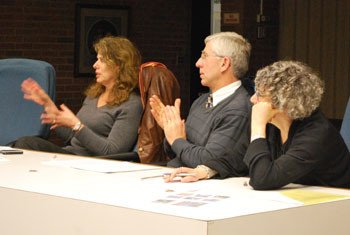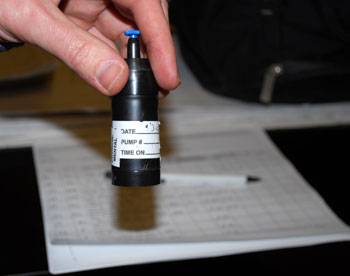Transitions for Ann Arbor Art Commission
Ann Arbor public art commission meeting (Jan. 25, 2012): Two new commissioners – Bob Miller and John Kotarski – attended the art commission’s first meeting of 2012, and joined other AAPAC members in approving two public art projects.

Ann Arbor public art commissioner Wiltrud Simbuerger, showing other commission members some proposals from artists for a mural at Allmendinger Park. A local artist, Mary Thiefels, has been selected for that project. (Photos by the writer.)
The group unanimously recommended selecting Ed Carpenter of Portland, Oregon for a $150,000 art project in the lobby of the city’s Justice Center, located at the corner of East Huron and Fifth Avenue. A task force had recommended the selection of Carpenter’s proposal from three finalists. It’s a sculpture called “Radius”.
Carpenter plans to create a hanging sculpture of dichroic glass, aluminum, stainless steel and lighting, including LED spot and flood lighting. Among the reasons for recommending Radius, the task force cited the sculpture’s metaphor: That the activities in the Justice Center have a “rippling” effect throughout the community, which echos the water sculpture by Herbert Dreiseitl that’s located in the plaza outside the building.
The Justice Center, a new building next to city hall, houses the 15th District Court and the Ann Arbor police department. The commission’s recommendation will be forwarded to the city council for approval.
In other action, the art commission voted to select Ann Arbor muralist Mary Thiefels for a mural project to be located on pillars at a building in Allmendinger Park. A task force had recommended her selection from among four finalists. Her proposal entails asking neighborhood residents for artifacts to create mosaics at the top and bottom of the pillars. The task force recommended that they continue to work with Thiefels on designing the remainder of the mural in the middle sections of the pillars.
Commissioners liked the concept of “found object” mosaics, but questioned whether the $10,000 budget was sufficient. They ultimately voted to approve selecting Thiefels for the project, contingent on her submission of a revised proposal and budget, with additional input from the task force. This project is the first one in a pilot mural program started last year by former commissioner Jeff Meyers.
AAPAC also discussed possible artwork for four sites connected to the East Stadium bridges, which are being reconstructed. The two commissioners who serve on a task force for that project – Wiltrud Simbuerger and Bob Miller – indicated that the budget recommendation will likely be at least $250,000 for artwork there. The task force is currently developing a request for proposals to be issued in the coming weeks.
In the context of developing their annual art plan for fiscal 2013, which by ordinance must be delivered to the city council by April 1, commissioners decided to hold a retreat next month. In addition to shaping the annual plan, the aim of the retreat is to develop a master plan that would provide a broader conceptual framework to guide AAPAC’s decisions. Input from an online survey of the public will also be used – the survey remains open until Feb. 20, and has garnered more than 400 responses so far. [Full Story]











